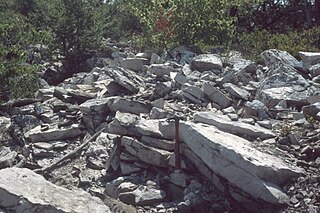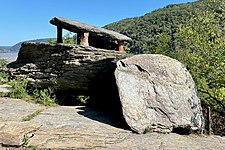
The Devonian Catskill Group or the Catskill Clastic wedge is a unit of mostly terrestrial sedimentary rock found in Pennsylvania and New York. Minor marine layers exist in this thick rock unit. It is equivalent to the Hampshire Formation of Maryland, West Virginia, and Virginia.
The Chilhowee Group is a sedimentary body composed of early Cambrian siliciclastic sedimentary rocks which crop out along the eastern margin of the Blue Ridge province in Alabama, Maryland, Tennessee, North Carolina, Virginia, and West Virginia. They represent a rift to passive margin sequence, with mostly coarse, feldspathic sandstones and conglomerates in the lower member and shales and phyllite in the upper members. The Chilhowee Group contains four formations; the Loudoun Formation, Weverton Formation, Harpers Formation and Antietam Formation. Another name for the Harpers formations is the Hampton formation, and the Antietam Formation is also known as the Erwin Formation. The Hampton Formation has minor economic importance in the area near the James River Face Wilderness. As of 1982 there were three quarries operating near the James River Face Wilderness. Those quarries produced roofing shale, light weight aggregate, and various materials for brick making. The Antietam Formation also had a minor economic importance, particularly from 1945 up until 1966. There were three quarries producing crushed quartzite, which was used to produce concrete aggregates, road metal and railroad ballast.

The Ordovician Martinsburg Formation (Om) is a mapped bedrock unit in Pennsylvania, New Jersey, Maryland, Virginia, and West Virginia. It is named for the town of Martinsburg, West Virginia for which it was first described. It is the dominant rock formation of the Great Appalachian Valley in New Jersey and Pennsylvania.

The Silurian Tuscarora Formation — also known as Tuscarora Sandstone or Tuscarora Quartzite — is a mapped bedrock unit in Pennsylvania, Maryland, West Virginia, and Virginia, US.

The Ordovician Juniata Formation is a mapped bedrock unit in Pennsylvania, West Virginia, Virginia, Tennessee, and Maryland. It is a relative slope-former occurring between the two prominent ridge-forming sandstone units: the Tuscarora Formation and the Bald Eagle Formation in the Appalachian Mountains.

The Clinton Group is a mapped unit of sedimentary rock found throughout eastern North America. The interval was first defined by the geologist Lardner Vanuxem, who derived the name from the village of Clinton in Oneida County, New York where several well exposed outcrops of these strata can be found. The Clinton Group and its lateral equivalents extend throughout much of the Appalachian Foreland Basin, a major structural and depositional province extending from New York to Alabama. The term has been employed in Kentucky, Maryland, Michigan, New York, Ohio, Pennsylvania, Tennessee, Virginia, and West Virginia, though in many of these areas the same interval is referred to as the Rose Hill, Rockwood, or Red Mountain Formations. Historically the term "Clinton" has also been assigned to several lower Silurian stratigraphic units in Ohio and Kentucky which are now known to be significantly older than the Clinton Group as it was originally defined. Many parts of this succession are richly fossiliferous, making the Clinton Group an important record of marine life during the early Silurian. Several economically valuable rock-types are found within this interval, though it is perhaps best known as a significant source of iron ore

Wills Creek Formation is a mapped Silurian bedrock unit in Pennsylvania, Maryland, Virginia, and West Virginia.

The Hamilton Group is a Devonian-age geological group which is located in the Appalachian region of the United States. It is present in New York, Pennsylvania, Maryland, Ohio, West Virginia, northwestern Virginia and Ontario, Canada, and is mainly composed of marine shale with some sandstone.

The Pennsylvanian Pottsville Formation is a mapped bedrock unit in Pennsylvania, western Maryland, West Virginia, Ohio, and Alabama. It is a major ridge-former in the Ridge-and-Valley Appalachians of the eastern United States. The Pottsville Formation is conspicuous at many sites along the Allegheny Front, the eastern escarpment of the Allegheny or Appalachian Plateau.

The Marcellus Formation or the Marcellus Shale is a Middle Devonian age unit of sedimentary rock found in eastern North America. Named for a distinctive outcrop near the village of Marcellus, New York, in the United States, it extends throughout much of the Appalachian Basin.

The New Oxford Formation is a mapped bedrock unit consisting primarily of sandstones, conglomerates, and shales. The New Oxford Formation was first described in Adams County, Pennsylvania in 1929, and over the following decade was mapped in adjacent York County, Pennsylvania and Frederick County, Maryland. It was described as "red shale and sandstone with beds of micaceous sandstone, arkose, and conglomerate." The majority of this early mapping was done by George Willis Stose, Anna Isabel Jonas, and Florence Bascom.

The Conococheague Formation is a mapped Appalachian bedrock unit of Cambrian age, consisting primarily of limestone and dolomite. It occurs in central Maryland, southern and central Pennsylvania, the Valley and Ridge of Virginia and easternmost West Virginia.

The Rockwell Formation is a late Devonian and early Mississippian mapped bedrock unit in West Virginia, Maryland, and Pennsylvania, in the United States.
Rockwell Run is a mountain stream in Morgan County, West Virginia. It is a tributary of the Potomac River.

The Devonian Brallier Formation is a mapped bedrock unit in Pennsylvania, Maryland, West Virginia, and Virginia.
The Gettysburg Formation is a mapped bedrock unit consisting primarily of sandstones, conglomerates, and shales.
The Hammer Creek Formation is a mapped bedrock unit consisting primarily of conglomerate, coarse sandstone, and shale.

The Ledger Formation or Ledger Dolomite is a geologic formation in Pennsylvania, United States.
The Waynesboro Formation is a limestone, dolomite, and sandstone geologic formation in Virginia, Maryland, Pennsylvania and West Virginia. In some areas it is composed of limestone and dolomite. The Waynsboro Formation is one of the formations that make up the Shenandoah Valley. It dates back to the Cambrian period and is not considered fossiliferous.
Anna Jonas Stose was a major geological pioneer, who worked for the American Museum of Natural History, Maryland Geological Survey, Pennsylvania Geological Survey, Virginia Geological Survey, and the United States Geological Survey. She is best known for her work mapping the Appalachian Mountain Range, documenting the structure of and exposure to the rock formations, and tracing crystalline rocks. Stose was among the first to implement petrographic and structural techniques to the Appalachian Mountains, which were still in development at the time. This was rare because women at this time didn't do physical work in the fields, and her hard efforts are now noted and appreciated. She contributed largely to the Geologic Map of Virginia and the Geologic Map of the United States.


















